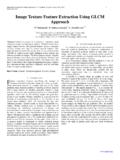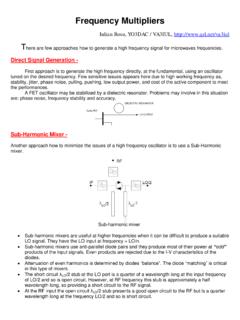Transcription of COVER FEATURE MATRIX FACTORIZATION TECHNIQUES FOR ...
1 Computer 42 COVER FEATUREP ublished by the IEEE Computer Society0018-9162/09/$ 2009 IEEE Such systems are particularly useful for entertainment products such as movies, music, and TV shows. Many cus-tomers will view the same movie, and each customer is likely to view numerous different movies. Customers have proven willing to indicate their level of satisfaction with particular movies, so a huge volume of data is available about which movies appeal to which customers. Com-panies can analyze this data to recommend movies to particular customers. RecommendeR system stRategiesBroadly speaking, recommender systems are based on one of two strategies. The content filtering approach creates a profile for each user or product to characterize its nature. For example, a movie profile could include at-tributes regarding its genre, the participating actors, its box office popularity, and so forth. User profiles might include demographic information or answers provided on a suitable questionnaire.
2 The profiles allow programs to associate users with matching products. Of course, content-based strategies require gathering external infor-mation that might not be available or easy to collect. A known successful realization of content filtering is the Music Genome Project, which is used for the Internet radio service A trained music analyst scores Modern consumers are inundated with choices. Electronic retailers and content providers offer a huge selection of prod-ucts, with unprecedented opportunities to meet a variety of special needs and tastes. Matching consumers with the most appropriate products is key to enhancing user satisfaction and loy-alty. Therefore, more retailers have become interested in recommender systems, which analyze patterns of user interest in products to provide personalized recommenda-tions that suit a user s taste. Because good personalized recommendations can add another dimension to the user experience, e-commerce leaders like and Netflix have made recommender systems a salient part of their websites.
3 As the Netflix Prize competition has dem-onstrated, MATRIX FACTORIZATION models are superior to classic nearest-neighbor TECHNIQUES for producing product recom-mendations, allowing the incorporation of additional information such as implicit feedback, temporal effects, and confidence levels. Yehuda Koren, Yahoo Research Robert Bell and Chris Volinsky, AT&T Labs ResearchMATRIX FACTORIZATION TECHNIQUES FOR RECOMMENDER SYSTEMS 43 AuGuSt 2009well-defined dimensions such as depth of character de-velopment or quirkiness; or completely uninterpretable dimensions. For users, each factor measures how much the user likes movies that score high on the correspond-ing movie factor. Figure 2 illustrates this idea for a simplified example in two dimensions. Consider two hypothetical dimen-sions characterized as female- versus male-oriented and serious versus escapist. The figure shows where several well-known movies and a few fictitious users might fall on these two dimensions.
4 For this model, a user s predicted rating for a movie, relative to the movie s average rating, would equal the dot product of the movie s and user s lo-cations on the graph. For example, we would expect Gus to love Dumb and Dumber, to hate The Color Purple, and to rate Braveheart about average. Note that some mov-ies for example, Ocean s 11 and users for example, Dave would be characterized as fairly neutral on these two dimensions. MATRIX FACTORIZATION methodsSome of the most successful realizations of latent factor models are based on MATRIX FACTORIZATION . In its basic form, MATRIX FACTORIZATION characterizes both items and users by vectors of factors inferred from item rating patterns. High correspondence between item and user factors leads to a each song in the Music Genome Project based on hundreds of distinct musical characteristics. These attributes, or genes, capture not only a song s musical identity but also many significant qualities that are relevant to understanding listeners musi-cal preferences.
5 An alternative to content filtering relies only on past user behavior for example, previous transactions or product ratings without requiring the creation of explicit profiles. This approach is known as col-laborative filtering, a term coined by the developers of Tapestry, the first recom-mender Collaborative filtering analyzes relationships between users and interdependencies among products to identify new user-item associations. A major appeal of collaborative fil-tering is that it is domain free, yet it can address data aspects that are often elusive and difficult to profile using content filter-ing. While generally more accurate than content-based TECHNIQUES , collaborative filtering suffers from what is called the cold start problem, due to its inability to ad-dress the system s new products and users. In this aspect, content filtering is superior. The two primary areas of collaborative filtering are the neighborhood methods and latent factor models. Neighbor-hood methods are centered on computing the relationships between items or, alternatively, between users.
6 The item-oriented approach evaluates a user s preference for an item based on ratings of neighboring items by the same user. A product s neighbors are other products that tend to get similar ratings when rated by the same user. For example, consider the movie Saving Private Ryan. Its neighbors might include war movies, Spielberg movies, and Tom Hanks movies, among others. To predict a par-ticular user s rating for Saving Private Ryan, we would look for the movie s nearest neighbors that this user actually rated. As Figure 1 illustrates, the user-oriented approach identifies like-minded users who can complement each other s ratings. Latent factor models are an alternative approach that tries to explain the ratings by characterizing both items and users on, say, 20 to 100 factors inferred from the ratings patterns. In a sense, such factors comprise a computerized alternative to the aforementioned human-created song genes. For movies, the discovered factors might measure obvious dimensions such as comedy versus drama, amount of action, or orientation to children; less Joe#2#3#1#4figure 1.
7 The user-oriented neighborhood method. Joe likes the three movies on the left. To make a prediction for him, the system finds similar users who also liked those movies, and then determines which other movies they liked. In this case, all three liked Saving Private Ryan, so that is the first recommendation. Two of them liked Dune, so that is next, and so on. COVER FEATURE computer 44vector qi f, and each user u is associ-ated with a vector pu f. For a given item i, the elements of qi measure the extent to which the item possesses those factors, positive or negative. For a given user u, the elements of pu measure the extent of interest the user has in items that are high on the corresponding factors, again, posi-tive or negative. The resulting dot product, qiT pu, captures the interaction between user u and item i the user s overall interest in the item s characteristics. This approximates user u s rating of item i, which is denoted by rui, leading to the estimate rui = qiT pu.
8 (1) The major challenge is computing the map-ping of each item and user to factor vectors qi, pu f. After the recommender system completes this mapping, it can easily esti-mate the rating a user will give to any item by using Equation 1. Such a model is closely related to singular value decom-position (SVD), a well-established technique for identifying latent semantic factors in information retrieval. Applying SVD in the collaborative filtering domain requires factoring the user-item rating MATRIX . This often raises difficulties due to the high portion of missing values caused by sparse-ness in the user-item ratings MATRIX . Conventional SVD is undefined when knowledge about the MATRIX is incom-plete. Moreover, carelessly addressing only the relatively few known entries is highly prone to overfitting. Earlier systems relied on imputation to fill in missing ratings and make the rating MATRIX However, im-putation can be very expensive as it significantly increases the amount of data.
9 In addition, inaccurate imputation might distort the data considerably. Hence, more recent works3-6 suggested modeling directly the observed rat-ings only, while avoiding overfitting through a regularized model. To learn the factor vectors (pu and qi), the system minimizes the regularized squared error on the set of known ratings: min**,qp(,)ui (rui - qiTpu)2 + (|| qi ||2 + || pu ||2) (2) Here, is the set of the (u,i) pairs for which rui is known (the training set). The system learns the model by fitting the previously observed ratings. However, the goal is to generalize those previous ratings in a way that predicts future, unknown ratings. Thus, the system should avoid overfitting the observed data by regularizing the learned parameters, whose magnitudes are penalized. The constant controls recommendation. These methods have become popular in recent years by combining good scalability with predictive accuracy. In addition, they offer much f lexibility for model-ing various real-life situations.
10 Recommender systems rely on different types of input data, which are often placed in a MATRIX with one dimension representing users and the other dimension representing items of interest. The most convenient data is high-quality explicit feedback, which includes explicit input by users regarding their interest in products. For example, Netflix collects star ratings for movies, and TiVo users indicate their preferences for TV shows by pressing thumbs-up and thumbs-down buttons. We refer to explicit user feedback as ratings. Usually, explicit feedback com-prises a sparse MATRIX , since any single user is likely to have rated only a small percentage of possible items. One strength of MATRIX FACTORIZATION is that it allows incorporation of additional information. When explicit feedback is not available, recommender systems can infer user preferences using implicit feedback, which indirectly reflects opinion by observing user behavior including pur-chase history, browsing history, search patterns, or even mouse movements.









